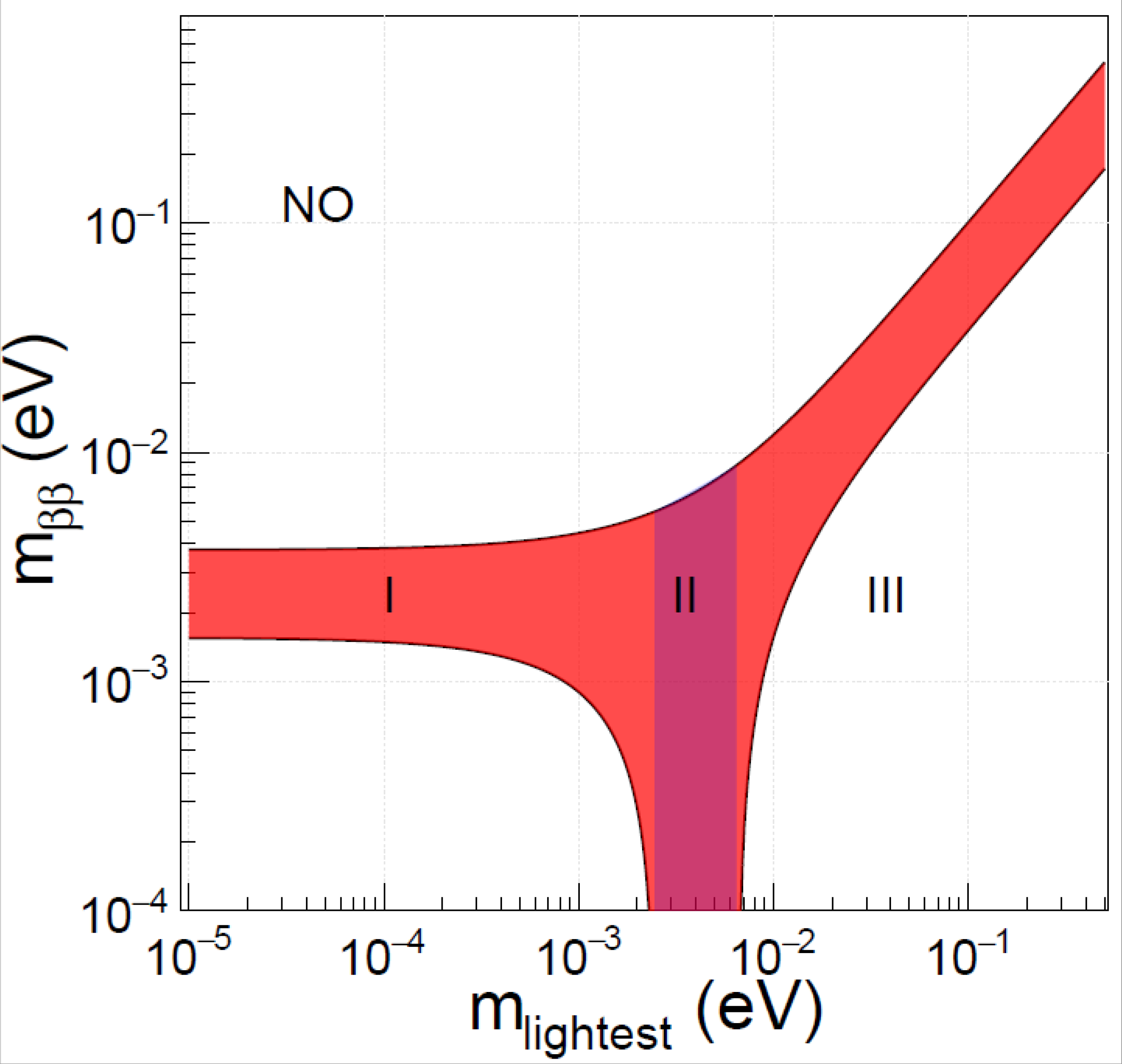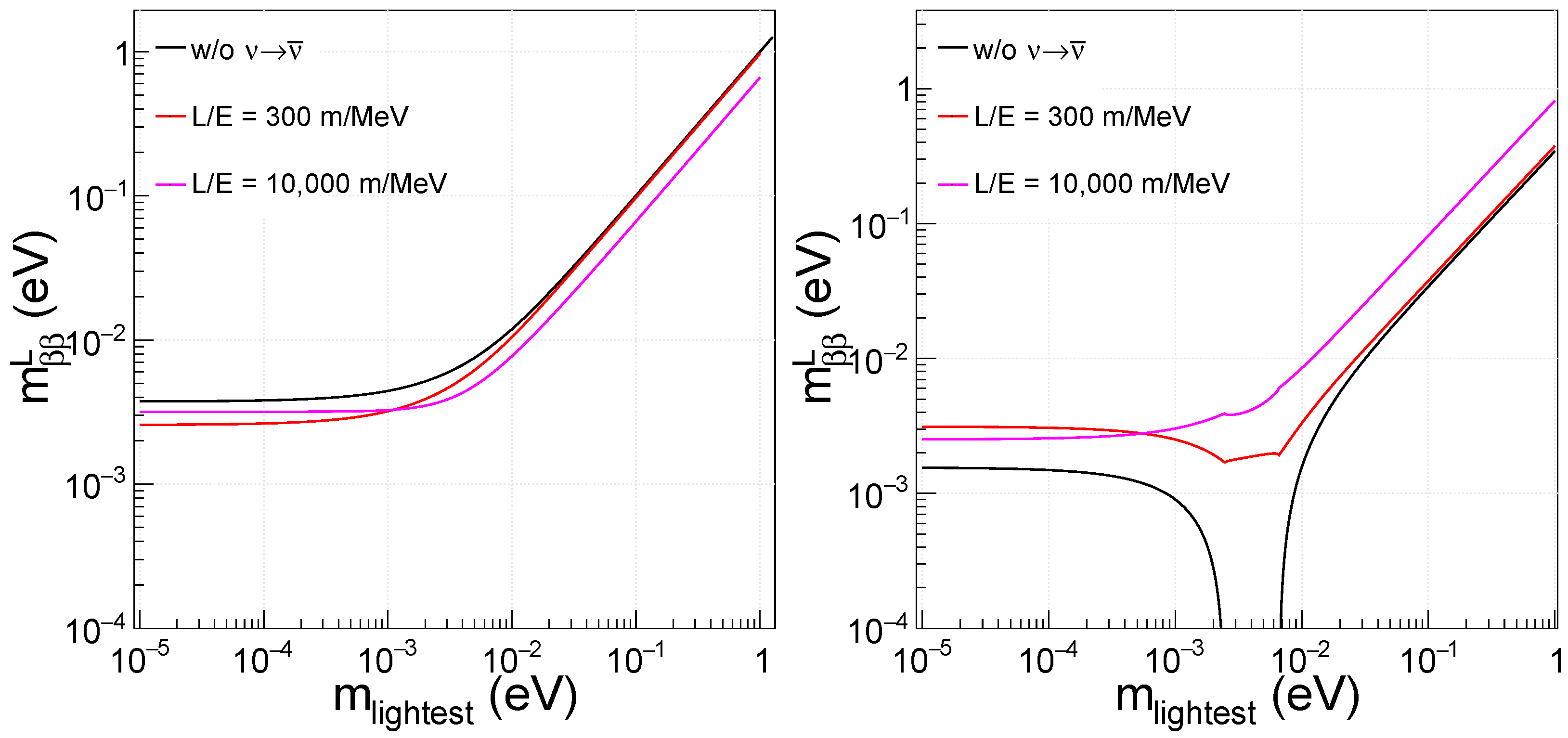1. Introduction
The discovery of neutrino oscillation proves that at least two neutrinos should have nonzero mass and three of the flavors mix among each other [
1]. Neutrino oscillation data are sensitive to the mass-squared differences of the neutrino (
and
), which allows us to set an upper limit on the absolute mass of two neutrinos. The current best fit value of
eV
and
eV
[
2] leads to the upper limits
meV and
meV for normal ordering (NO,
). One of the the direct ways of measuring the absolute mass of a neutrino is by precisely measuring the energy spectrum of beta particles from single
-decay. In addition, the cosmological observation provides the upper limit on the sum of neutrino masses.
Another important way to probe the neutrino mass is by detecting neutrinoless double-beta decay, which would occur if neutrinos are Majorana particles, i.e., neutrinos are their own anti-particle, and the active light neutrinos are the mediator of the decay [
3,
4,
5,
6]. The Majorana nature of the neutrino allows the process of neutrino to antineutrino oscillation, which is studied in several works [
7,
8,
9,
10,
11,
12,
13,
14,
15,
16,
17,
18]. In this paper, we study the effective Majorana neutrino mass with neutrino to antineutrino oscillation.
This paper is organized in the following way.
Section 2 describes the theory of neutrino to antineutrino oscillations. In
Section 3, we derive the expressions for Majorana phases that result in the lowest possible effective Majorana neutrino mass. We show the enhancement in the lowest possible effective Majorana masses due to neutrino to antineutrino oscillation in
Section 4. Finally, we summarize and conclude this work in
Section 5.
2. Neutrino to Antineutrino Oscillation
The oscillation between a neutrino and antineutrino is an allowed process if the lepton number is not a good quantum number, which is true if the neutrino is a Majorana particle. The rate of this oscillation is suppressed due to the small mass of the neutrino. The amplitude of
in propagation from the source to a detector at a distance
L is given by [
7,
8,
9,
10,
11,
12,
13,
14,
15,
16,
17,
18]
The same for the CP-conjugate process
is
where
K and
are functions of kinematical factors and nuclear matrix elements, and
due to the CP invariance in a strong interaction. The neutrino mass is denoted by
with
, and
E stands for neutrino energy. The parameters
(
) are elements of the PMNS matrix, which is the lepton mixing matrix, and it is parameterized with three mixing angles, one Dirac CP phase, and two Majorana phases (if the neutrino is a Majorana particle):
where
,
. The neutrino oscillation in propagation depends on mixing angles
,
,
, and one Dirac CP phase
, along with neutrino mass-squared differences. On the other hand, the Majorana phases (without losing generality, Majorana phases can be restricted in
),
and
, have no impact on neutrino oscillation; thus, the neutrino oscillation experiments are blind to these phases.
The probability of neutrino to antineutrino oscillation is given by
with
We can write the same for the CP-conjugate process
as
with
We call
and
the “effective neutrino mass” in the presence of
oscillations. Equation (
6) boils down to the effective Majorana neutrino mass (
) with
, and this can be measured in neutrinoless double-beta decay experiments. We discuss
in the next section.
3. Neutrinoless Double-Beta Decay
The observation of neutrinoless double-beta decay not only confirms the Majorana nature of the neutrino but provides the measurement of ethe ffective neutrino mass [
3,
4,
5,
6],
where
is the neutrino mass for
1, 2, 3. The effective neutrino mass
depends on Majorana phases
and
. Putting the elements of the PMNS matrix in Equation (
7), one can write
The minimum value of
is [
19]
Comparing Equations (
8) and (
9), Majorana phases corresponding to a minimum
in different regions are estimated. In region I (we checked that in region I, the condition
is true over whole range of
with the allowed range of
; therefore,
), the values of Majorana phases are
and
, whereas in region III,
, and
with the minimum value of
. Therefore, Majorana phases responsible for minimum
are different in regions I to III. In region II, there is a continuous change of
and
as the functions of the lightest neutrino mass. This dependence of
and
on neutrino mixing angles and masses is given by
where
With oscillation parameters
,
,
eV
, and
eV
, we find that the minimum value of
is zero in the range of 2.5 meV
6.5 meV. In
Figure 1, we show these regions as functions of lightest mass (
for NO).
We note that in the case of a neutrino mass spectrum with normal ordering, one can have
as a consequence of an “accidental” relation involving neutrino masses, mixing angles, and the Majorana phases. However, there does not exist a symmetry which forbids neutrinoless double-beta decay, although in this case, the neutrinoless double-beta decay will be allowed. The corresponding effective Majorana mass parameter is determined by [
20]
where
q is the momentum of the virtual Majorana neutrino. For the average momentum
, one typically has
. Thus, if the region
is equal to zero, this contribution is nonzero, but negligible [
20].
4. Results
This section is devoted to describing the results obtained in this study. First, we discuss the modification of the effective Majorana neutrino mass due to the propagation of antineutrinos and detect this as a neutrino in a detector at a distance
L from the source. We rewrite Equation (
6) in terms of mass-squared differences as
Figure 2 shows the
dependence of
with three choices of the lightest neutrino masses, 0.1 meV, 3 meV, and 20 meV, which are in region I, II, and III, respectively. In this paper, we describe all the results with
in units of m/MeV. These results are also valid for
of same value but in units of km/GeV. The amplitude of oscillation depends on the neutrino mixing angles as well as on the neutrino masses, whereas the frequency depends on the mass-squared difference and
. The imprint of two independent mass-squared differences are seen in the plot of
.
With
m/MeV, the oscillation is predominantly due to
, and the amplitude is
. For
m/MeV, the second term starts to grow, and its effect is visible in the second and third panel of
Figure 2. Since neutrino to antineutrino oscillation introduces an additional phase into the expression of effective neutrino mass, the allowed regions of
and
are same. However, an important point to note is that if the value of Majorana phases and the lightest neutrino mass in nature are such that the effective mass of the neutrino is suppressed, and
events are therefore suppressed, then the observation of neutrino to antineutrino oscillation can be a signature for measuring the Majorana phases as well as neutrino masses.
In
Figure 3, we present the dependence of
on the lightest mass (
for NO) for three different
values. With
m/MeV (or km/GeV), the major contributing factor to the difference between
and
arises due to the third term in Equation (
13). For the lightest neutrino at around 0.1 meV, the oscillation due to
can change the effective mass from its maximum value to a small—close to minimum—value and vice versa. As the lightest neutrino mass increases,
-induced oscillation cannot cover the whole range between the highest and lowest limit of
. In this case, with higher values of
,
-induced oscillation can change
significantly. This explains why we see a larger relative change in
at lower
with
= 300 m/MeV, and almost no change
meV. We find a relative change in
over the whole range of
with
m/MeV staying almost the same. The discontinuity feature with a minimum
with a nonzero
arises due to the different behavior of Majorana phases in the three regions we describe in
Section 3.
If the neutrino mass ordering is an inverted ordering (IO), is nonzero over the whole range of , suppressions of events due to zero do not arise. In addition, the bands of are rather narrow for IO in the whole range of , and remains inside this band; therefore, the difference between and for IO will not be large.
5. Conclusions
The observation of neutrinoless double-beta decay confirms the Majorana nature of the neutrino. The rate of events provides the measurement of the effective neutrino mass. The dependence of on unknown Majorana phases results in a large uncertainty in the interpretation of the lightest neutrino mass from . In addition, it is important to note that if the neutrino mass ordering adheres to a normal order and if is in range of [2.5–6] meV, = 0 with a certain combination of Majorana phases.
In this study, we have derived the expressions for Majorana phases for which effective the Majorana mass becomes zero. We have distinguished three regions of neutrino mass for which the Majorana phases corresponding to the minimum behave in a different way. These are region I: meV, II: 2.5 meV 6.5 meV, and III: meV with NO. We have considered neutrino to antineutrino oscillation, which is a theoretically allowed process if a neutrino is a Majorana particle, and explored its role in the effective Majorana neutrino mass measurement. The neutrino to antineutrino oscillation provides an indirect measurement of the effective Majorana neutrino mass, which would be different than that measured in the experiment due to the additional phases introduced in propagation. This oscillation phase depends on neutrino mass-squared differences and -like neutrino flavor oscillation. However, the amplitude of oscillation not only depends on mixing angles but also on the absolute masses of neutrinos. This feature of neutrino to antineutrino oscillation will play an important role in neutrino mass measurement.
We have shown that the effective Majorana neutrino () mass in neutrino to antineutrino oscillation is changed by a larger amount when the lightest neutrino mass is less than region I and II when is as small as 300 m/MeV or km/GeV, where -induced oscillation contributes to the additional phases. Therefore, reactor and accelerator-based neutrino experiment data can be used to search for the signature of if lies in region I and II. If becomes as large as m/MeV or km/GeV, then is different than for the whole range of we consider this study, which is [0.01–] meV. The experimental techniques and possible backgrounds for measuring are within the scope of more detailed study.









